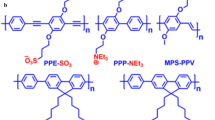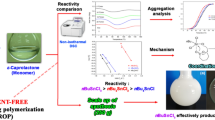Abstract
Novel 3-hexylthiophene-based hyperbranched conjugated polymers containing triphenylamine and benzo [c] [1, 2, 5] thiadiazole moieties were synthesized by Suzuki coupling polymerization of tris (4-bromophenyl) amine, 2,2′-(3-hexylthiophene-2,5-diyl) bis(4,4,5,5-tetramethyl-1,3,2-dioxaborolane) and 4,7-dibromobenzo [c] [1, 2, 5] thiadiazole. Organic solvent-soluble polymers with number-average molecular weights of 24,000 and 42,000 g/mol were obtained in 54–57 % yields. Their structures, molecular weights and thermal properties were characterized via proton nuclear magnetic resonance (1H NMR) and Fourier transform infrared (FT-IR) spectroscopies, gel permeation chromatography (GPC), thermogravimetric analysis (TGA), differential scanning calorimetry (DSC) and wide-angle powder X-ray diffraction (XRD) measurements. Optical investigation by UV–vis and fluorescence spectroscopies revealed that the incorporation of the benzo [c] [1, 2, 5] thiadiazole moiety in the hyperbranched polymer structure resulted in a red-shift of the maximum absorption wavelength and an increase in the solution-photoluminescence quantum yield, indicating an extension of the conjugation length. The UV–vis, DSC and XRD results demonstrated that the aggregation of conjugated polymer chains could effectively be reduced by the hyperbranched structures and that conjugation length extension via the introduction of benzo [c] [1, 2, 5] thiadiazole units led to the coexistence of both crystalline and amorphous phases in the solid state and in solution upon addition of a non-solvent.









Similar content being viewed by others
References
McCullough RD, Tristram-Nagle S, Williams SP, Lowe RD, Jayaraman M (1993) Self-orienting head-to-tail poly (3-alkylthiophenes): new insights on structure–property relationships in conducting polymers. J Am Chem Soc 115:4910–4911
Chen T-A, Wu X, Rieke RD (1995) Regiocontrolled synthesis of poly (3-alkylthiophenes) mediated by Rieke Zinc: their characterization and solid-state properties. J Am Chem Soc 117:233–244
Bao Z, Dodabalapur A, Lovinger AJ (1996) Soluble and processable regioregular poly (3-hexylthiophene) for thin film field-effect transistor applications with high mobility. Appl Phys Lett 69:4108–4110
Sirringhaus H, Tessler N, Friend RH (1998) Integrated optoelectronic devices based on conjugated polymers. Science 280:1741–1744
Agrawal AK, Jenekhe SA (1993) Synthesis and processing of heterocyclic polymers as electronic, optoelectronic, and nonlinear optical materials. 2. New series of conjugated rigid-rod polyquinolines and polyanthrazolines. Macromolecules 26:895–905
Hancock JM, Gifford AP, Champion RD, Jenekhe SA (2008) Block Co-oligomers for Organic Electronics and Optoelectronics: Synthesis, Photophysics, Electroluminescence, and Field-Effect Charge Transport of Oligothiophene-b-oligoquinoline-b-oligothiophene Triblock Co-oligomers. Macromolecules 41:3588–3597
Arias AC, MacKenzie JD, McCulloch I, Rivnay J, Salleo A (2010) Materials and applications for large area electronics: solution-based approaches. Chem Rev 110:3–24
Pron A, Gawrys P, Zagorska M, Djurado D, Demadrille R (2010) Electroactive materials for organic electronics: preparation strategies, structural aspects and characterization techniques. Chem Soc Rev 39:2577–2632
Pan H, Wu Y, Li Y, Liu P, Ong BS, Zhu S, Xu G (2007) Benzodithiophene copolymer—A low-temperature, solution-processed high-performance semiconductor for thin-film transistors. Adv Funct Mater 17:3574–3579
Li Y, Wu Y, Liu P, Birau M, Pan H, Ong BS (2006) Poly (2,5-bis (2-thienyl) -3,6-dialkylthieno [3,2-b] thiophene)s—High-mobility semiconductors for thin-film transistors. Adv Mater 18:3029–3032
Chen L, Li X, Ying W, Zhang X, Guo F, Li J, Hua J (2013) 5,6-Bis (octyloxy) benzo [c] [1,2,5] thiadiazole-bridged dyes for dye-sensitized solar cells with high open-circuit voltage performance. Eur J Org Chem 2013:1770–1780
Ma F, Shi W, Mi H, Luo J, Lei Y, Tian Y (2013) Triphenylamine-based conjugated polymer/I − complex as turn-on optical probe for mercury (II) ion. Sensors Actuators B Chem 182:782–788
Lim ZB, Xue B, Bomma S, Li H, Sun S, Lam YM, Belcher WJ, Dastoor PC, Grimsdale AC (2011) New moderate bandgap polymers containing alkoxysubstituted-benzo [c] [1,2,5] thiadiazole and thiophene-based units. J Polym Sci A Polym Chem 49:4387–4397
Reisch A, Komber H, Voit B (2007) Kinetic Analysis of Two Hyperbranched A2 + B3 Polycondensation Reactions by NMR Spectroscopy. Macromolecules 40:6846–6858
Krämer M, Kopaczynska M, Krause S, Haag R (2007) Dendritic polyamine architectures with lipophilic shells as nanocompartments for polar guest molecules: A comparative study of their transport behavior. J Polym Sci A Polym Chem 45:2287–2303
Paul GK, Mwaura J, Argun AA, Taranekar P, Reynolds JR (2006) Cross-linked hyperbranched arylamine polymers as hole-transporting materials for polymer LEDs. Macromolecules 39:7789–7792
Dong H, Zheng R, Lam JWY, Häussler M, Qin A, Tang BZ (2005) A new route to hyperbranched macromolecules: syntheses of photosensitive poly (aroylarylene)s via 1,3,5-regioselective polycyclotrimerization of bis (aroylacetylene)s. Macromolecules 38:6382–6391
Sun M, Li J, Li B, Fu Y, Bo Z (2005) Toward high molecular weight triphenylamine-based hyperbranched polymers. Macromolecules 38:2651–2658
Sunder A, Mülhaupt R, Haag R, Frey H (2000) Hyperbranched polyether polyols: a modular approach to complex polymer architectures. Adv Mater 12:235–239
Liou G-S, Lin H-Y, Yen H-J (2009) Synthesis and characterization of electroactive hyperbranched aromatic polyamides based on A2B-type triphenylamine moieties. J Mater Chem 19:7666–7673
Bo Z, Schluter AD (2003) “AB2 + AC2” approach to hyperbranched polymers with a high degree of branching. Chemical Communications 2354–2355
J.H obson L, M. Kenwright A (1997) A simple ‘one pot’ route to the hyperbranched analogues of Tomalia's poly (amidoamine) dendrimers. Chemical Communications 1877–1879
Smet M, Schacht E, Dehaen W (2002) Synthesis, characterization, and modification of hyperbranched poly (arylene oxindoles) with a degree of branching of 100 %. Angew Chem Int Ed 41:4547–4550
Bharathi P, Moore JS (2000) controlled synthesis of hyperbranched polymers by slow monomer addition to a core. Macromolecules 33:3212–3218
Ishida Y, Sun ACF, Jikei M, M-a K (2000) Synthesis of hyperbranched aromatic polyamides starting from dendrons as ABx monomers: effect of monomer multiplicity on the degree of branching. Macromolecules 33:2832–2838
Li B, Li J, Fu Y, Bo Z (2004) Porphyrins with four monodisperse oligofluorene arms as efficient red light-emitting materials. J Am Chem Soc 126:3430–3431
Kanibolotsky AL, Berridge R, Skabara PJ, Perepichka IF, Bradley DDC, Koeberg M (2004) Synthesis and properties of monodisperse oligofluorene-functionalized truxenes: highly fluorescent star-shaped architectures. J Am Chem Soc 126:13695–13702
Tour JM (1996) Conjugated macromolecules of precise length and constitution organic synthesis for the construction of nanoarchitectures. Chem Rev 96:537–554
Belletête M, Bouchard J, Leclerc M, Durocher G (2005) Photophysics and solvent-induced aggregation of 2,7-carbazole-based conjugated polymers. Macromolecules 38:880–887
Li K, Wang Q (2004) Synthesis and solution aggregation of polystyrene − oligo (p-phenyleneethynylene) − polystyrene triblock copolymer. Macromolecules 37:1172–1174
Bouchard J, Belletête M, Durocher G, Leclerc M (2003) Solvatochromic properties of 2,7-carbazole-based conjugated polymers. Macromolecules 36:4624–4630
Ma H, Liu S, Luo J, Suresh S, Liu L, Kang SH, Haller M, Sassa T, Dalton LR, Jen AKY (2002) Highly efficient and thermally stable electro-optical dendrimers for photonics. Adv Funct Mater 12:565–574
Qu J, Shiotsuki M, Kobayashi N, Sanda F, Masuda T (2007) Synthesis and properties of carbazole-based hyperbranched conjugated polymers. Polymer 48:6481–6490
Li J, Sun M, Bo Z (2007) Synthesis of hyperbranched polymers with precise conjugation length. J Polym Sci A Polym Chem 45:1084–1092
Okamoto K, Housekeeper JB, Michael FE, Luscombe CK (2013) Thiophene based hyperbranched polymers with tunable branching using direct arylation methods. Polym Chem 4:3499–3506
He Q, Huang H, Yang J, Lin H, Bai F (2003) Synthesis and spectroscopic properties of a series of hyperbranched conjugated molecules with 1,3,5-triphenylbenzene as cores. J Mater Chem 13:1085–1089
Hollamby MJ, Nakanishi T (2013) The power of branched chains: optimising functional molecular materials. J Mater Chem C 1:6178–6183
Wang H-S, Su M-S, Wei K-H (2010) Synthesis and characterization of donor–acceptor poly (3-hexylthiophene) copolymers presenting 1,3,4-oxadiazole units and their application to photovoltaic cells. J Polym Sci A Polym Chem 48:3331–3339
Zen A, Saphiannikova M, Neher D, Grenzer J, Grigorian S, Pietsch U, Asawapirom U, Janietz S, Scherf U, Lieberwirth I, Wegner G (2006) Effect of molecular weight on the structure and crystallinity of poly (3-hexylthiophene). Macromolecules 39:2162–2171
Kim J (2002) Assemblies of conjugated polymers Intermolecular and intramolecular effects on the photophysical properties of conjugated polymers. Pure Appl Chem 74:2031–2044
Sonar P, Singh SP, Sudhakar S, Dodabalapur A, Sellinger A (2008) High-mobility organic thin film transistors based on benzothiadiazole-sandwiched dihexylquaterthiophenes. Chem Mater 20:3184–3190
Sonar P, Singh SP, Leclere P, Surin M, Lazzaroni R, Lin TT, Dodabalapur A, Sellinger A (2009) Synthesis, characterization and comparative study of thiophene-benzothiadiazole based donor-acceptor-donor (D-A-D) materials. J Mater Chem 19:3228–3237
Verploegen E, Miller CE, Schmidt K, Bao Z, Toney MF (2012) Manipulating the morphology of P3HT–PCBM bulk heterojunction blends with solvent vapor annealing. Chem Mater 24:3923–3931
Zha D, Chen L, Wu F, Wang H, Chen Y (2013) Donor–acceptor-integrated conjugated polymers based on carbazole [3,4-c:5,6-c] bis [1,2,5] thiadiazole with tight π–π stacking for photovoltaics. J Polym Sci, Part A: Polym Chem 51:565–574
Bredas JL, Heeger AJ (1990) Theoretical investigation of gas-phase torsion potentials along conjugated polymer backbones: polyacetylene, polydiacetylene, and polythiophene. Macromolecules 23:1150–1156
Gettinger CL, Heeger AJ (1994) The effect of intrinsic rigidity on the optical properties of PPV derivatives. Mol Cryst Liq Cyst 256:507–512
DiCésare N, Belletête M, Leclerc M, Durocher G (1999) Intermolecular Interactions in Conjugated Oligothiophenes. 2. Quantum Chemical Calculations Performed on Crystalline Structures of Terthiophene and Substituted Terthiophenes. J Phys Chem A 103:803–811
Ruini A, Caldas MJ, Bussi G, Molinari E (2002) Solid state effects on exciton states and optical properties of PPV. Phys Rev Lett 88:206403
Ferretti A, Ruini A, Molinari E, Caldas MJ (2003) Electronic properties of polymer crystals: the effect of interchain interactions. Phys Rev Lett 90:086401
Acknowledgments
This research was fully supported by Vietnam National Foundation for Science and Technology Development (NAFOSTED) under grant number “104.02-2013.18”.
Author information
Authors and Affiliations
Corresponding author
Rights and permissions
About this article
Cite this article
Nguyen, H.T., Nguyen, LT.T., Nguyen, T.T. et al. Synthesis of hyperbranched conjugated polymers based on 3-hexylthiophene, triphenylamine and benzo [c] [1,2,5] thiadiazole moieties: convenient synthesis through suzuki polymerization and impact of structures on optical properties. J Polym Res 21, 552 (2014). https://doi.org/10.1007/s10965-014-0552-y
Received:
Accepted:
Published:
DOI: https://doi.org/10.1007/s10965-014-0552-y




